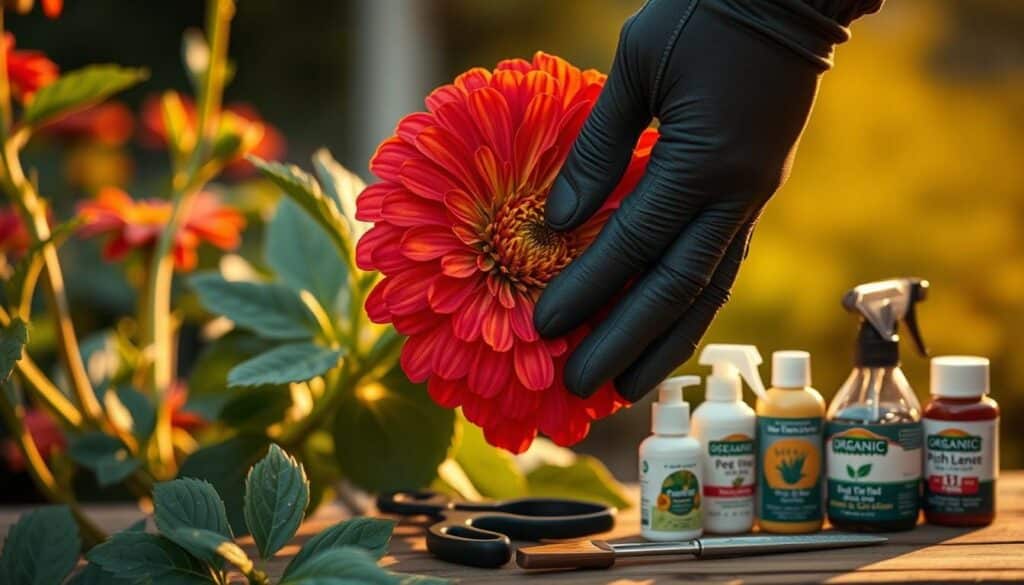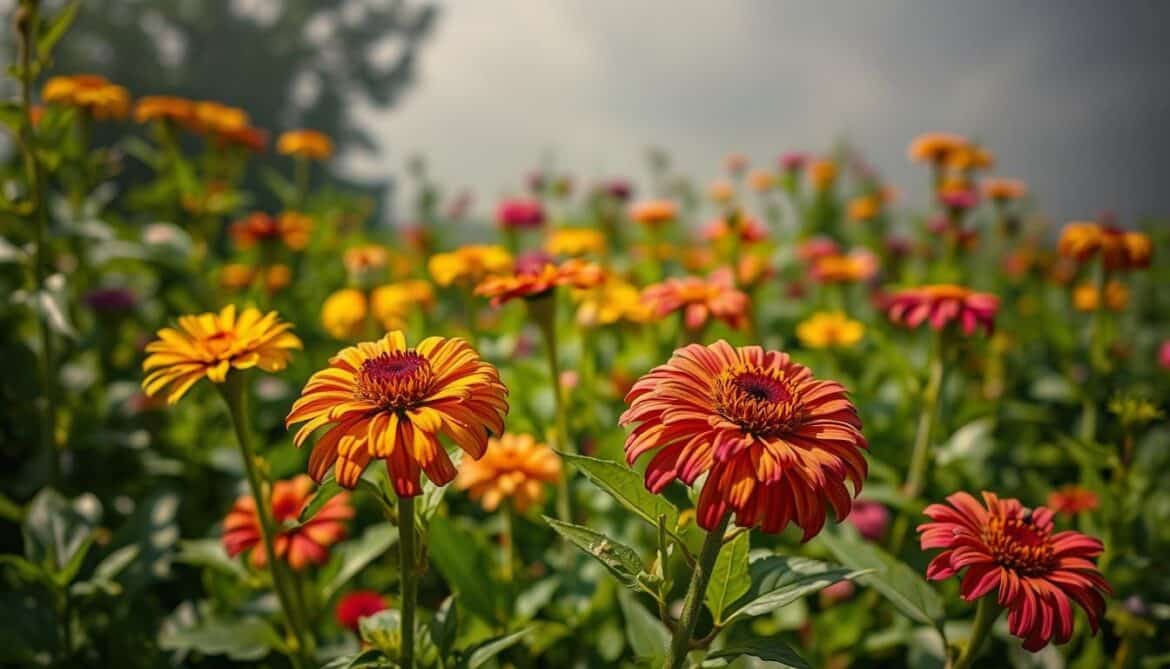As a passionate gardener, I’ve seen my zinnias go from bright and healthy to weak and fading. Bacterial zinnia diseases taught me that stopping them is key to saving these flowers.
Diseases like zinnia bacterial blight can ruin your garden, turning vibrant flowers into dying plants. It’s important for gardeners to know about these threats to protect their flowers.
Bacterial infections in zinnias are tricky because they can live for a long time. Xanthomonas campestris pv. zinniae, a main bacteria, can stay in dried leaves for up to a year. This makes stopping them hard and needing a good plan to fight them.
Key Takeaways
- Bacterial zinnia diseases can cause significant aesthetic and economic damage
- Some zinnia varieties like Crystal and Star series have natural disease resistance
- Early detection is critical for managing bacterial infections
- Environmental conditions play a significant role in disease development
- Integrated pest management approaches offer the most complete protection
Understanding Bacterial Diseases in Zinnias
Bacterial diseases are a big problem for zinnia growers. They can harm the health and beauty of these flowers. It’s important to understand and manage these diseases to keep zinnias safe.
Overview of Bacterial Pathogens
Zinnia leaf spot is caused by Xanthomonas campestris pv. zinniae. This bacterium only attacks zinnias. Symptoms can show up quickly, even in July.
- Bacterial pathogens specific to zinnias
- Xanthomonas campestris as primary disease agent
- High risk of rapid infection spread
The Importance of Identifying Diseases
Finding zinnia xanthomonas disease early is key. The first signs are small, clear spots (1-2 mm) with yellow edges. These spots can grow bigger and merge, causing damage.
| Disease Characteristic | Description |
|---|---|
| Initial Spot Size | 1-2 mm |
| Potential Enlargement | Up to 5 mm |
| Dead Area Formation | 0.1-0.3 inches long |
Impact on Garden Aesthetics
Bacterial infections can ruin a zinnia garden. They cause discolored leaves, stunted growth, and can kill plants. To prevent this, treat seeds with bleach and choose resistant varieties.
Keeping zinnias healthy requires watching for diseases and taking action. This way, these beautiful flowers can keep gardens looking great.
Common Bacterial Zinnia Diseases
Bacterial diseases are a big problem for zinnia growers. They can harm the health and beauty of these flowers. It’s important to know about these infections to keep zinnias looking great.
Bacterial Leaf Spot: A Persistent Threat
Zinnia bacterial leaf scorch is caused by Xanthomonas campestris pv. zinniae. It’s common in gardens and loves warm weather. When it’s over 80°F, it spreads fast.
- Symptoms start as gray, water-soaked spots on leaves
- Yellow or tan spots appear with clear edges
- It can ruin flower heads and kill the plant
Bacterial Wilt: Systemic Plant Destruction
Zinnia erwinia disease is another serious problem. It attacks the plant’s inner systems. This stops water and nutrients from getting to the plant.
“Bacterial wilt can turn healthy zinnias into wilted, lifeless plants within days.” – Plant Pathology Experts
Soft Rot: Silent Garden Destroyer
Soft rot is a deadly disease that loves warm, humid places. It quickly breaks down plant parts, making stems and leaves mushy.
| Disease | Primary Symptoms | Optimal Temperature Range |
|---|---|---|
| Bacterial Leaf Spot | Gray water-soaked areas, yellow spots | 77°F – 86°F |
| Bacterial Wilt | Systemic plant collapse, wilting | 80°F – 86°F |
| Soft Rot | Mushy tissue, rapid decomposition | 80°F – 86°F |
Gardeners need to watch out and use prevention to keep zinnias safe from these diseases.
Causes of Bacterial Infections in Zinnias
Bacterial diseases in zinnias come from many factors. These include the environment and the plants themselves. Knowing these causes helps gardeners keep their zinnias healthy and free from disease.
The soil is full of tiny bacteria. A single gram of soil can contain up to a billion bacteria. These include harmful types like zinnia pseudomonas disease and zinnia ralstonia disease. Bacteria can grow fast, doubling every 20 minutes.
Environmental Factors
Environmental conditions affect zinnia diseases a lot. Important factors include:
- Temperature range between 70-85 degrees Fahrenheit
- Prolonged leaf wetness
- High relative humidity
- Partial shade conditions
Soil Conditions
Soil is key in spreading bacterial infections. Pathogens can stay in soil from past seasons. This makes zinnias planted in the same spot more at risk. Planting the same plants over and over increases the chance of infection.
Plant Stress Factors
Stressed zinnias are more likely to get sick. Stressors include:
- Improper watering techniques
- Physical plant damage
- Overcrowding
- Nutrient imbalances
Gardeners can lower these risks. They can do this by growing plants carefully and keeping them healthy.
Symptoms of Bacterial Diseases
Spotting bacterial zinnia diseases early can save your garden. Zinnias face many bacterial threats. These can harm your plants if not treated.
Visual Signs on Leaves
Bacterial infections show up as specific leaf signs. Look out for:
- Angular, water-soaked brown spots
- Lesions that start on lower leaves and progress upward
- Dark brown to black margins around leaf spots
- Potential leaf yellowing and necrosis
Wilting and Stunting Symptoms
Zinnia burkholderia disease can stress plants. This leads to:
- Sudden wilting of entire plant sections
- Reduced overall plant growth
- Stunted stem development
- Premature leaf drop
Root Rot Characteristics
Root symptoms of bacterial zinnia diseases are harmful. Look for:
- Soft, mushy root tissues
- Darkened root coloration
- Reduced root mass
- Easy root separation when gently pulled
| Symptom Type | Characteristic Indicators | Potential Impact |
|---|---|---|
| Leaf Symptoms | Angular brown spots | Reduced photosynthesis |
| Plant Growth | Stunting and wilting | Decreased plant vigor |
| Root Health | Soft, discolored roots | Potential plant death |
Early detection is key to managing bacterial diseases in zinnias. Regular checks can help catch these signs early.
How Bacterial Diseases Spread
Bacterial diseases can ruin zinnia gardens in many ways. It’s key to know how they spread to stop zinnia leaf spot and zinnia bacterial blight.
Bacteria in zinnias use different ways to move between plants. They spread through water, soil, and insects.
Water and Moisture Transmission
Water is a big helper in spreading bacterial diseases. Water droplets can carry bacteria from sick to healthy zinnias. Important ways include:
- Overhead irrigation
- Rainfall during humid conditions
- Water droplets carrying bacterial cells
“Keeping zinnia foliage dry is essential in preventing bacterial disease spread.”
Soil Contamination Mechanisms
Soil can hold bacterial pathogens for a long time. Xanthomonas species hide in soil debris, ready to infect new zinnias. Soil gets contaminated through:
- Infected plant residues
- Contaminated gardening tools
- Improper crop rotation practices
Insect-Driven Transmission
Insects can spread bacterial diseases in unexpected ways. They can carry bacteria or make holes for pathogens. Common ways include:
- Piercing-sucking insects
- Leaf-feeding beetles
- Contaminated feeding apparatus
Knowing how diseases spread helps gardeners protect their zinnias. They can use this knowledge to prevent bacterial infections.
Prevention Strategies for Bacterial Zinnia Diseases
To keep zinnias safe from bacteria, we need a solid plan. This plan includes smart gardening and being ready to act. Knowing how to stop zinnia xanthomonas and zinnia erwinia diseases is key.
Crop Rotation Techniques
Changing where you plant zinnias is a smart move. It helps fight off bacterial diseases. Here’s why:
- It breaks disease cycles
- It cuts down on soil pathogens
- It stops bacteria from building up
- It lessens disease spread between seasons
Proper Watering Practices
How you water zinnias is very important. The right way to water can really help prevent disease. Here’s what works:
- Water in the early morning for quick drying
- Use drip irrigation to keep leaves dry
- Avoid watering from above in the evening
- Keep the soil moist but not wet

Disease-Resistant Varieties
Picking zinnias that are resistant to disease is a big help. Here’s what to do:
- Look for varieties known to resist disease
- Ask local experts for advice
- Find out which varieties are best at fighting off pathogens
- Choose plants that are naturally stronger
By using these strategies, gardeners can protect their zinnias from disease. This leads to healthier, more beautiful gardens.
Effective Control Measures
To keep zinnias safe from bacterial diseases, we need a mix of control methods. Knowing how zinnia pseudomonas disease works helps gardeners fight it well.
Bacterial diseases can ruin your garden. But, there are ways to stop them before they start.
Chemical Treatments
Chemicals are key in fighting bacterial diseases. Copper-based fungicides work well against many plant diseases. Here’s what research says:
- Spray plants weekly with copper-based solutions
- Focus treatments after periods of extended leaf wetness
- Use targeted bactericides specific to zinnia infections
Organic Control Options
Natural methods are also good for fighting diseases. They can work with chemicals:
- Implement Bacillus-based products
- Utilize plant extracts like EcoSwing and Regalia
- Rotate bactericide treatments every 7-14 days
Proper Sanitation Practices
Keeping your garden clean is vital to stop disease spread. Good plant care helps a lot:
- Remove and discard infected plant material
- Sterilize gardening tools between uses
- Maintain proper plant spacing for air circulation
- Avoid overhead watering that promotes moisture retention
Experts agree that fighting diseases needs a mix of chemicals, biology, and good gardening practices.
Role of Soil Health in Disease Management
Keeping the soil healthy is key to stopping zinnia ralstonia disease and zinnia leaf spot. The health of a plant starts with the soil. Soil conditions affect how well a plant can fight off bacterial infections.
To keep zinnias safe from bacteria, we need to focus on a few important steps:
- Conduct regular soil testing
- Monitor soil pH levels
- Enhance microbial activity
- Improve soil drainage
Importance of Soil Testing
Soil testing tells us about the nutrients and pH levels. For zinnias, a pH between 5.8 to 6.0 helps fight off bacteria.
| Soil Parameter | Optimal Range | Impact on Zinnia Health |
|---|---|---|
| Electrical Conductivity (EC) | 1.25 – 1.5 | Supports nutrient uptake |
| Soil pH | 5.8 – 6.0 | Reduces disease susceptibility |
Enhancing Soil Microbial Activity
Good microbes help fight diseases. Adding organic matter boosts these helpful microbes. They compete with harmful bacteria.
“Healthy soil is the first line of defense against plant diseases” – Plant Pathology Experts
Managing Soil pH and Drainage
Right drainage and pH levels are vital to stop zinnia bacterial infections. Too much water can lead to disease. So, improving drainage is key for plant health.
Impact of Weather on Bacterial Infections
Weather conditions are key in the spread of zinnia bacterial blight. Knowing how weather affects disease can help gardeners keep their flowers safe.

Humidity and Precipitation Dynamics
High humidity is perfect for zinnia burkholderia disease to grow. Moisture on plants lets bacteria spread fast. Gardeners should use methods to keep plants dry:
- Space plants for good air flow
- Water at soil level
- Don’t water from above
- Prune to cut down leaf density
Temperature Variations and Disease Progression
Temperature affects how fast bacteria spread. Bacteria grow best in warm, humid air between 77-86°F. This makes them spread quickly among zinnias.
| Temperature Range | Bacterial Infection Risk |
|---|---|
| Below 60°F | Low Risk |
| 60-75°F | Moderate Risk |
| 77-86°F | High Risk |
| Above 90°F | Reduced Risk |
Seasonal Considerations for Zinnia Health
Different seasons bring different challenges for zinnias. Late summer and early fall are when infections are most common because of the warm, moist weather.
“Prevention is always more effective than treatment when managing plant diseases.” – Plant Pathology Expert
Understanding weather’s role helps gardeners protect their zinnias from disease all season long.
Integrated Pest Management (IPM) Approaches
Controlling bacterial zinnia diseases needs a smart plan. Integrated Pest Management (IPM) helps gardeners fight off zinnia xanthomonas disease. It also keeps the environment safe.
IPM focuses on stopping problems before they start. It uses natural solutions first, then pesticides if needed. This way, it manages diseases in a complete way.
Combining Biological and Chemical Tools
For bacterial zinnia diseases, a mix of methods works best:
- Attract natural predators
- Use chemicals wisely
- Change control methods often
Monitoring and Scouting Techniques
Finding diseases early is key. Regular checks on plants can catch problems fast.
| Inspection Frequency | Focus Areas |
|---|---|
| Weekly | Leaf surfaces, stem conditions |
| Bi-weekly | Root health, soil moisture |
| Monthly | Overall plant vigor |
Timing Treatments for Maximum Efficacy
When you treat plants matters a lot. Proactive management means knowing when to act. It’s about the plant’s growth and the weather.
- Apply treatments early
- Watch humidity and temperature
- Get lab tests for exact diagnoses
Using these IPM strategies, gardeners can keep zinnias healthy. They fight off diseases well and keep the plants thriving.
Identifying Bacterial Infections Early
Spotting bacterial diseases in zinnias needs careful watching and quick action. Zinnia erwinia disease and zinnia leaf spot can harm your garden if not caught early. It’s key to act fast to save your flowers.
Managing diseases starts with knowing the early signs of bacterial infections. These signs might not show up on the whole plant. They can appear on just one stalk, depending on when the infection starts.
Critical Signs to Watch For
- Purplish spots with yellow halos on leaves
- Angular leaf lesions that appear translucent when held to light
- Sudden wilting of plant sections
- Unusual discoloration or texture changes in foliage
Conducting Regular Plant Inspections
Regular checks are your best defense against bacterial infections. Gardeners should look at zinnias every week. Focus on:
- Leaf undersides
- Plant stem bases
- Areas with constant moisture
- Places with high humidity
Technological Detection Methods
Modern gardening uses tech to find diseases sooner. Tools like digital microscopes and plant disease apps give early alerts about bacterial threats.
| Detection Tool | Accuracy | Cost |
|---|---|---|
| Digital Microscope | High | $100-$300 |
| Plant Disease App | Medium | Free-$50 |
| Professional Lab Testing | Very High | $50 per specimen |
Acting quickly can stop bacterial infections from spreading. This protects your zinnia garden’s health and beauty.
The Importance of Extension Services
Agricultural extension services are key for gardeners facing tough plant health issues. They help with zinnia pseudomonas disease and zinnia bacterial blight. These services offer expert advice and resources for managing plant diseases.
- Professional diagnostic services for plant diseases
- Free educational workshops
- Research-based recommendations
- Direct access to plant pathology experts
Resources for Plant Health Professionals
Gardeners can get vital information on zinnia bacterial diseases from extension services. They offer tools for diagnosis, sample submission, and personal consultations.
“Knowledge is the first line of defense against plant diseases” – Agricultural Extension Specialist
Community Engagement and Learning
Extension workshops teach gardeners how to spot and manage bacterial infections. They learn prevention techniques through hands-on training and expert talks.
Connecting with Plant Health Experts
Extension services link scientific research to gardening. They connect gardeners with experts for accurate diagnoses and treatments of zinnia diseases.
Case Studies of Bacterial Zinnia Outbreaks
Bacterial zinnia diseases have caused big problems for gardeners and farmers all over the world. Looking at real cases helps us learn how to manage and prevent these diseases.
In August 2021, a study in Shibing, Guizhou, China, showed how bad bacterial diseases can be for zinnias. It found that leaf spot disease hit about 60% of zinnias in the area.
Analyzing Historical Outbreak Patterns
Important things we’ve learned from past outbreaks include:
- Bacteria can grow fast and spread quickly
- They can infect a lot of plants at once
- They can spread through different ways
Lessons in Disease Prevention
The study gave us key tips for managing zinnia ralstonia disease:
- Bacteria can hide in small amounts, even when you can’t see them
- It takes a lot of bacteria to make a plant sick
- They can spread through many things
| Transmission Method | Risk Level |
|---|---|
| Soil Contamination | High |
| Water Exposure | Very High |
| Contaminated Tools | Moderate |
Community Response Strategies
Handling bacterial zinnia diseases well needs teamwork. Quickly removing infected plants and keeping things clean are key steps.
Spotting the disease early and acting fast can stop it from spreading too far.
Gardeners and farmers must stay alert. They need to use strong monitoring and prevention methods to keep zinnias safe from harmful bacteria.
Conclusion: Best Practices for Healthy Zinnias
To keep zinnias healthy, you need a solid plan and active gardening habits. It’s important to know how plants, the environment, and diseases interact. This knowledge helps you grow zinnias well.
Start by choosing strong zinnia varieties like ‘California Giant’ and ‘Benary Giants’. They are more resistant to diseases. Make sure your plants have enough space, sunlight, and air. This helps prevent diseases that thrive in damp conditions.
Using a mix of methods is key to keeping zinnias healthy. Watch your plants closely, cut off sick leaves, and use natural pest control. For example, planting marigolds or basil with your zinnias can help fight off diseases. These steps help your zinnias stay vibrant and disease-free all season.
Keep learning and be ready to change your approach as needed. Stay up-to-date with new research and use local resources. This will help you grow strong, healthy zinnias for years to come.

